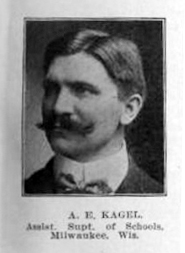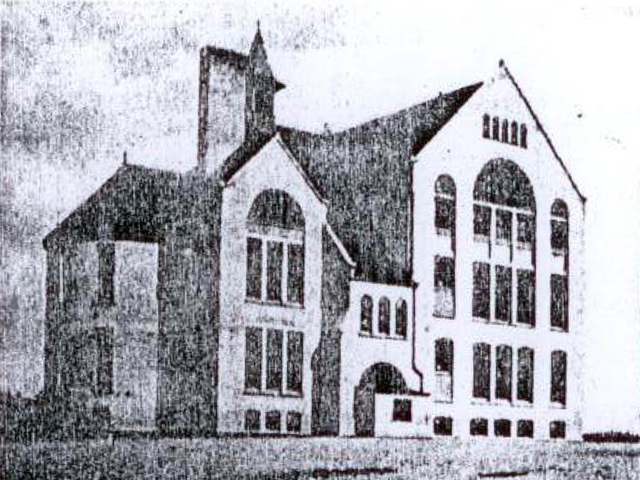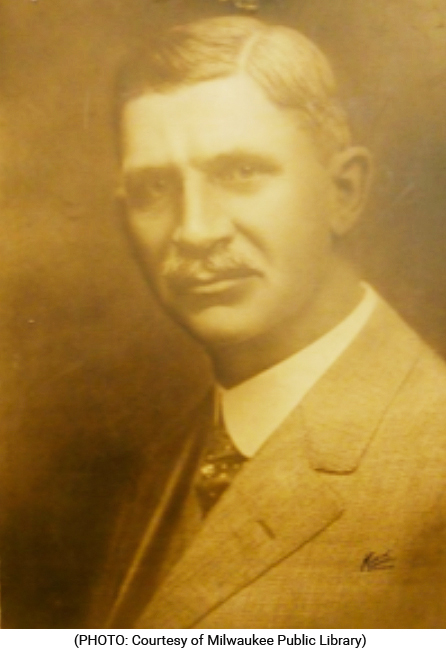There are countless Milwaukeeans who have left an indelible mark on the city, even though folks rarely utter their names. More than the Kilbourns, Juneaus and Walkers, these folks, who toiled for their town and have now been relegated to relative obscurity, have captured my attention.
One of them is Albert Kagel, who is best remembered these days for the namesake of the Milwaukee Public School on 12th and Mineral where he started his long, distinguished career in public education in the city.
With Milwaukee Public Schools’ traditional-calendar schools re-opening this week, it seems like an appropriate time to consider Kagel’s place in Milwaukee history.
Albert Ernst Kagel was born in Memel, East Prussia, in 1864 to 35-year-old Jacob Kagel and his wife Caroline Komschlieo. Germany surrundered Memel, on the east coast of the Baltic Sea, in the 1919 Treaty of Versailles and a few years later it became part of Lithuania, and it’s now called Klaipeda.
The family settled on 8th and Orchard Streets on the South Side, and Kagel apparently initially attended St. Stephen’s Lutheran School – attached to what was likely also his family’s church, at 5th and Scott Streets – before transferring to the old 11th Ward School (now Forest Home Avenue School), that was called the Franklin School.
After graduating in 1881 from the old East Side High School – which was replaced by Riverside High, but was located on what is now the parking lot of Lincoln Middle School on Cass and Knapp Streets – Kagel earned a two-year degree in 1884 from the Milwaukee Normal School, graduating with honors.
Kagel spent just a single year in the classroom, working as a grade assistant at the 8th Ward School – the school that would later bear his name in 1884 (though the building itself would soon be replaced with the current structure). Here he cut his teeth as a German language teacher in a district in which the study of German was de rigueur.

In 1885, Kagel was appointed principal at the First Ward Branch School on Maryland Avenue, which then occupied a two-room brick schoolhouse (pictured above) designed by architect Leonard Schmidtner, who also drew St. Stanislaus Church.
When a new building, designed by no less than Henry Koch, was erected in 1887 (pictured below), Kagel was principal. When, five years later, Schnetzky and Liebert designed a large addition – and the school was renamed the 18th Ward School (because the neighborhood had now grown large enough to have its own alderman), Kagel was still at the helm.

This view of Maryland Avenue School cannot be recreated now, as a large addition
was built to this side of the building in 1893.
Could Kagel have also been the reason why Schnetzky and Liebert also designed a new schoolhouse at St. Stephen’s at the same time? Perhaps so.
Kagel married Milwaukee-born Elise Mathilde Ebert in April 1887 and together they had six children, all girls – except for Percy, born in 1895 – Edna (born in 1888), Hilda (1893), Ruth (1902), Esther (1906) and Elizabeth (1908).
Tragically, Percy would die just five days before his 14th birthday in 1909, and the Kagels lost Ruth at about the same age, in 1916.
Kagel remained principal at the 18th Ward School for 16 years, until 1901-02, when MPS superintendent H.O.R. Siefert tapped him – and, two years earlier, Walter Allen, whose name is memorialized in the Allen-Field School on 8th and Lapham (coincidentally, right on Kagel’s childhood block) – to serve as assistant superintendents.
In his new post, Kagel oversaw the district’s kindergarten and art programs until 1910, when elementary education became his focus. Kagel remained in the position under two more superintendents, too.
In 1904, Kagel was charged with organizing Milwaukee’s education exhibit at the St. Louis World’s Fair and during his tenure he traveled to other cities to study their public school systems.
When MPS superintendent Carroll Pearce resigned in 1913, Kagel spent a year running the show as acting superintendent of the district until Milton Potter was hired in 1914.
Around the same time, interestingly, Kagel became associated with the Milwaukee Mutual Building and Savings Association (which appears to survive today as Bank Mutual), where he spent five years as a director and then another five as a vice president.
Also active in civic groups, Kagel served as president and vice president of the South Division Civic Association. His youngest daughters, Esther and Elizabeth – and perhaps other children – attended South Division High.
By 1921, Kagel had become ill and spent the next two years battling poor health, before he died at home on Tuesday, Nov. 20, 1923. The fact that the entire Milwaukee Public Schools district closed at noon the day after his funeral is a testament to Kagel’s stature.
Every school in the district sent flowers to Kagel’s Queen Anne home at 563 Scott Street (1031 W. Scott St.). A service was held at the Kagel home, presided over by Rev. B. C. Sievers from St. Stephen’s.
Teachers arrived at the funeral en masse, "in a body" – as did a large group of school principals, who had saluted Kagel and his contributions at a principals meeting held the same day at the Public Museum. Also on the Thursday, the school board passed resolutions celebrating the man and his work on behalf of Milwaukee children.
The mutual association and South Division Civic Association turned out, too. The list of pallbearers reads like a who’s who of MPS at the time: Superintendent Potter, and the principals of Mineral Street (now Kagel), Forest Home Avenue and Scott Street (now Anna M. Doerfler) Schools. Honorary pallbearers included the top officers of Milwaukee Mutual.
Kagel was interred at Pilgrim’s Rest, a German immigrant cemetery on the South Side.
Soon after, a Kagel Memorial Association was organized and fundraising began for a permanent memorial. Spearheaded by Emma Gardner, principal of Bartlett Avenue School – erected as a branch of Maryland Avenue School during Kagel’s tenure – the group settled on the idea of an Albert E. Kagel Memorial Teachers Room at the Milwaukee Public Library.
Working with library director M. S. Dudgeon, the group was successful and the Kagel Room was officially dedicated on April 5, 1929. A bronze memorial plaque was erected and a portrait of Kagel was hung.
The second-floor room, which was accessed through the Science Room (now a part of the Krug Rare Books Room), actually opened in May 1928 with a collection of 3,800 books on education, as well as other printed resources.
I asked MPL what became of the Kagel Room and Tom Olson, who works in the Humanities Room, did some digging, but other than a few details, the story is cloudy.
"I have not been able to determine exactly when the Kagel Room was no longer used and its books added to the general collection," told me, noting that the science room underwent renovations in summer 1949 and was moved to the new building annex in 1950. "Since the Kagel Room and its collection had been in the library since 1928, it would seem that most if not all of the contents went to the Annex.
"After the 1956 addition was completed, the Science Department moved to the first floor west side rear end of the building," Olson added. "There is no further mention of the Kagel Room, so one could presume that it was dismantled as part of the modernization and relocation of the Science Room."
According to Olson, the plaque and portrait are held in the library's archives.
These days, when I pass the school where Kagel got his start, and when I enter the one he helped build – and which has continued to serve Milwaukee children in the intervening 129 years – I always think of Albert Kagel and his enduring contributions to this town.
Born in Brooklyn, N.Y., where he lived until he was 17, Bobby received his BA-Mass Communications from UWM in 1989 and has lived in Walker's Point, Bay View, Enderis Park, South Milwaukee and on the East Side.
He has published three non-fiction books in Italy – including one about an event in Milwaukee history, which was published in the U.S. in autumn 2010. Four more books, all about Milwaukee, have been published by The History Press.
With his most recent band, The Yell Leaders, Bobby released four LPs and had a songs featured in episodes of TV's "Party of Five" and "Dawson's Creek," and films in Japan, South America and the U.S. The Yell Leaders were named the best unsigned band in their region by VH-1 as part of its Rock Across America 1998 Tour. Most recently, the band contributed tracks to a UK vinyl/CD tribute to the Redskins and collaborated on a track with Italian novelist Enrico Remmert.
He's produced three installments of the "OMCD" series of local music compilations for OnMilwaukee.com and in 2007 produced a CD of Italian music and poetry.
In 2005, he was awarded the City of Asti's (Italy) Journalism Prize for his work focusing on that area. He has also won awards from the Milwaukee Press Club.
He has be heard on 88Nine Radio Milwaukee talking about his "Urban Spelunking" series of stories, in that station's most popular podcast.




